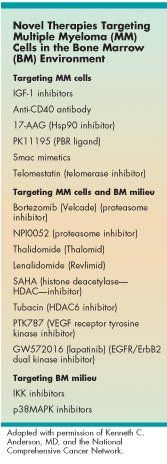Thalidomide Has 'Changed the Paradigm' in Myeloma Rx
Thalidomide (Thalomid) has "changed the paradigm" for treating multiple myeloma, and advances in understanding the relationship between myeloma cells and the bone marrow microenvironment promise to change it even more, Kenneth C. Anderson, MD, of the Dana-Farber Cancer Institute, said at the National Comprehensive Cancer Network (NCCN) 11th Annual Conference.
HOLLYWOOD, Florida Thalidomide (Thalomid) has "changed the paradigm" for treating multiple myeloma, and advances in understanding the relationship between myeloma cells and the bone marrow microenvironment promise to change it even more, Kenneth C. Anderson, MD, of the Dana-Farber Cancer Institute, said at the National Comprehensive Cancer Network (NCCN) 11th Annual Conference.
Dr. Anderson said that many attempts to develop combination chemotherapy regimens better than melphalan (Alkeran)/prednisone regimens have been largely unsuccessful, but this situation is changing quickly. He expects at least one new drug approval per year over the next few years and a new therapeutic emphasis on targeting not only the tumor cell but also the microenvironment.
"We are getting spoiled in myeloma," Dr. Anderson said, predicting that oncologists will increasingly be able to transform what was an incurable cancer into a manageable chronic illness.
Thalidomide in combination with dexamethasone (Thal/Dex), accounts for part of that optimism. [The FDA recently approved the combination for use in newly diagnosed myeloma patients.] Dr. Anderson said that thalidomide:
Produces a 50% or greater decrease in paraprotein in one-third of relapsed and/or refractory myeloma patients.
Produces a 47% overall response in refractory myeloma.
Has a 63% response rate as initial therapy vs 41% for dexamethasone alone.
Does not compromise subsequent mobilization of peripheral blood stem cells for transplant.
Combined with melphalan, produces an 80% response rate as initial therapy in elderly myeloma patients vs 48% with melphalan alone.
He noted: "Thalidomide has changed how we manage the elderly patient who is not a transplant candidate and how we think about the management of newly diagnosed patients." Adding thalidomide to combination melphalan/prednisone also has the advantage in newly diagnosed patients of increasing median overall survival from 30.3 to 56+ months (HR 1.9, P = .008). "In addition," Dr. Anderson said, "it is a completely oral regimen."
Autologous stem cell transplant (ASCT) remains the standard of care for patients younger than 65. Dr. Anderson said that the advantages of ASCT include a significantly higher complete response (CR) rate, compared with conventional chemotherapy; a survival benefit related to achieving CR (median event-free survival of 12 months vs 4 months with conventional chemotherapy); and increased median overall survival. "Transplants should not be restricted to patients responding to initial chemotherapy," Dr. Anderson said.
The question of how to manage relapse after transplant is being addressed in clinical trials. Dr. Anderson noted that double autotransplant appears to improve survival but that the survival benefit associated with the second transplant was seen only in patients who did not have a CR from the first transplant, an unexpected result. "Some patients achieving a near CR after the first transplant may be more chemosensitive and benefit from the second transplant," he said.
The most widely tested agent for maintenance therapy after conventional chemotherapy or high-dose chemotherapy with stem cell transplant is interferon-alfa, but Dr. Anderson said that the few months of additional survival are "more than balanced by toxicity." He noted that in one study, patients given interferon-alfa gained 5.8 months of survival but with 4.1 months of serious toxicity.
Pamidronate (Aredia) with or without thalidomide has been associated with prolonged median and 3-year progression-free survival, he said, but did not affect overall survival when used as maintenance therapy.
Dr. Anderson said that salvage therapy with Thal/Dex has produced responses in about half of relapsed myeloma patients who did not respond to either agent alone. Bortezomib (Velcade) is the new player in this area, he said. The drug, which targets NF-kappa-B, is approved for relapsed myeloma and produces a 78% improvement in median time to progression in such patients, compared with dexamethasone.

The need to overcome resistant myeloma is driving much of the research into interactions between the myeloma cell and the bone marrow microenvironment (see Table). Clinical trials combining agents that target different parts of this interaction are progressing.
Cell signaling is being attacked with bortezomib/dexamethasone and with thalidomide/lenalidomide (Revlimid)/dexamethasone. Targets identified by proteomics are being attacked with bortezomib and the DNA damaging agents melphalan and liposomal doxorubicin (Doxil), he said. Lenalidomide, which is currently approved for transfusion-dependent anemia in myelodysplastic syndromes, is next in the pipeline for multiple myeloma, he said, predicting that it would be approved this year.
Navigating AE Management for Cellular Therapy Across Hematologic Cancers
A panel of clinical pharmacists discussed strategies for mitigating toxicities across different multiple myeloma, lymphoma, and leukemia populations.